Couillon is a trick taking game of Belgian descent. It has several unique
features including the option for player to set the trump suit at the beginning of the hand and a scoring mechanism in which players tally scores by erasing from the scoresheet.
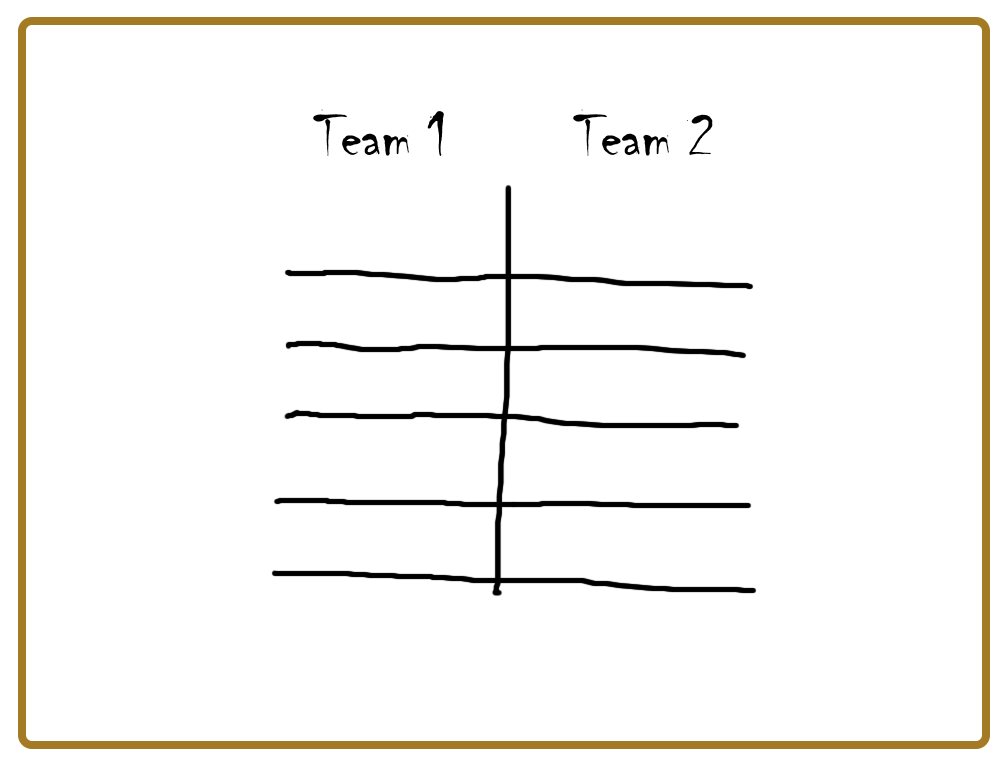
Couillon is designed to be played by four players playing in two
partnerships of two players each. It uses a special 24 card deck, which can
be created by removing all
cards lower than nine from a standard deck. The standard ranking of the cards used to play Couillon is as follows (from high to low); Ace, King, Queen, Jack, 10, 9. Since the scoring in this game is displayed by erasing from a scoresheet, scores should be recorded on something which can easily be erased from, such as a chalkboard or dry-erase board. To create the scoring indicator, a vertical line should be made down the middle of the board. The players consisting of one partnership are written on one side of this line and the names from the other on the other side. Five horizontal lines, equally spaced should then be drawn down the length of the original vertical line.
Determination of partnerships for the game can be determined in several ways. One of the most common method is to have each player draw a card from the shuffled deck. The players drawing the two highest cards would play as partners against the players drawing the two lowest. If two or more players draw a card of the same denomination, those players should draw an additional card until drawing a card of a rank another player has not
previously drawn. The player drawing the highest ranked card of all is set as the first dealer. After each hand, the deal rotates in a clockwise direction around the table. The players should seat themselves at the table such that each player is seated directly across from his partner.
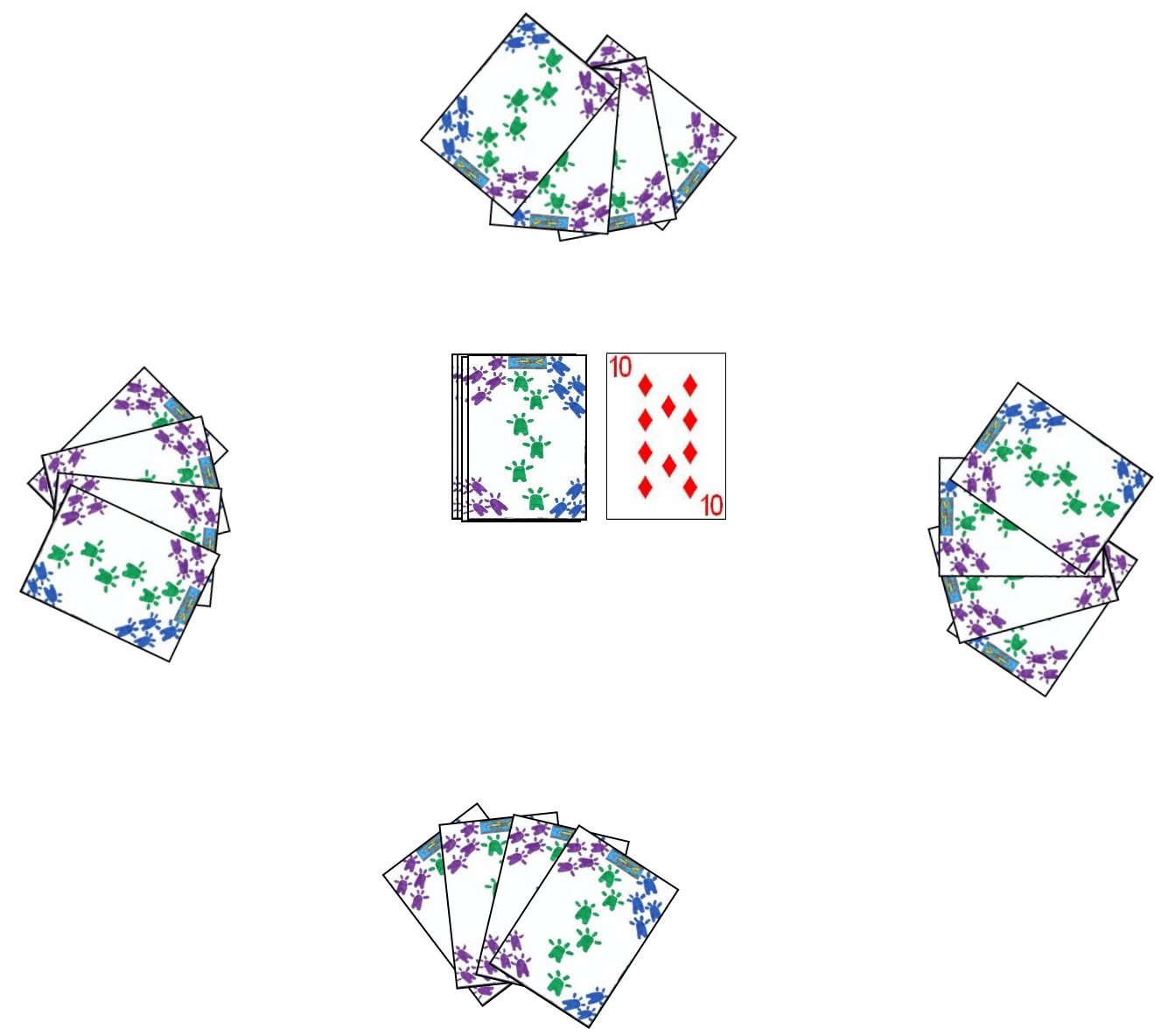
Once the partnerships and first dealer have been determined, the dealer would then thoroughly shuffle the deck and offer it to the player at his immediate right to cut. After the cut, the dealer begins dealing, starting with the player to his left. He deals in face-down packets of two cards to each player in a clockwise direction around the table until each player has four total cards. He places the remaining 8 cards, also face-down, in a small stack in the center of the table. He then turns up the top card of this stack and places it face-up beside the stack.
After the turn-up, the determination of the trump suit occurs. This begins with the player to the immediate left of the dealer. This player has the opportunity to either accept or decline the face-up card as the trump suit. He does this simply my stating "Accept" or "Decline". If he declines this suit, the opportunity to accept the suit rotates around the table until all four players have spoken. If any player accepts the turn-up card's suit as trump suit, that suit becomes the designated trump suit for the hand. If all four players decline this suit, the bottom card of the center stack is placed face-up on top of the previous turned-up card. The suit of this new card is then set as the trump suit for the hand.
Once the trump suit to be used for the hand is determined, the player to the dealer's left plays the first card to the first trick. He may play any card from his hand to start the trick. Each remaining player, in a clockwise direction then adds one card to the trick. When playing to a trick started by another player, a player may, if having cards of the trump suit, play a card of the trump suit. If he does not have or does not want to play such a card, he must instead play a card of the suit originally led to the trick. If he does not have a card of the suit originally led, he may play any other card from his hand. The highest card of the trump suit played to the trick wins it. If no cards of the trump suit were played to the trick, the highest card of the suit originally led to the trick wins it. The winner of each trick leads the first card to start the next trick.
Cards won in a trick are set aside, in a pile for that partnership. They should be kept face-down and are no longer used in the current hand but are retained for determining scores at the end of the hand.
After all four tricks have been played, each partnership sorts through the pile of cards from tricks won by the partnership to determine their score for the hand. The following chart shows the scoring value for each of the cards in the deck:
| Card | Scoring Value |
|---|
| Ace | 4 |
| King | 3 |
| Queen | 2 |
| Jack | 1 |
| 10, 9 | 0 |
|
|
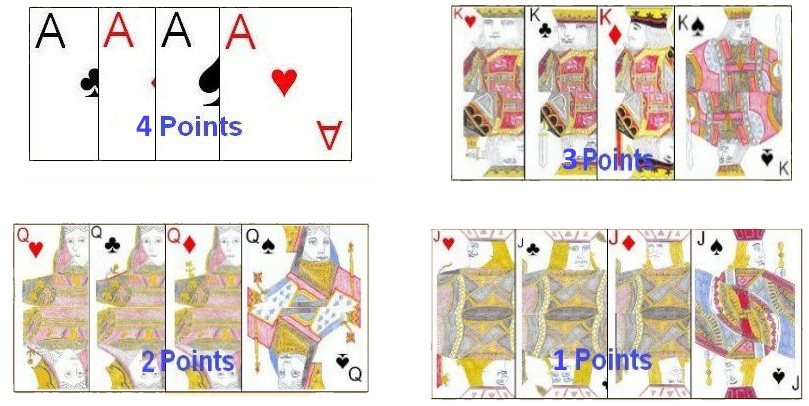
|
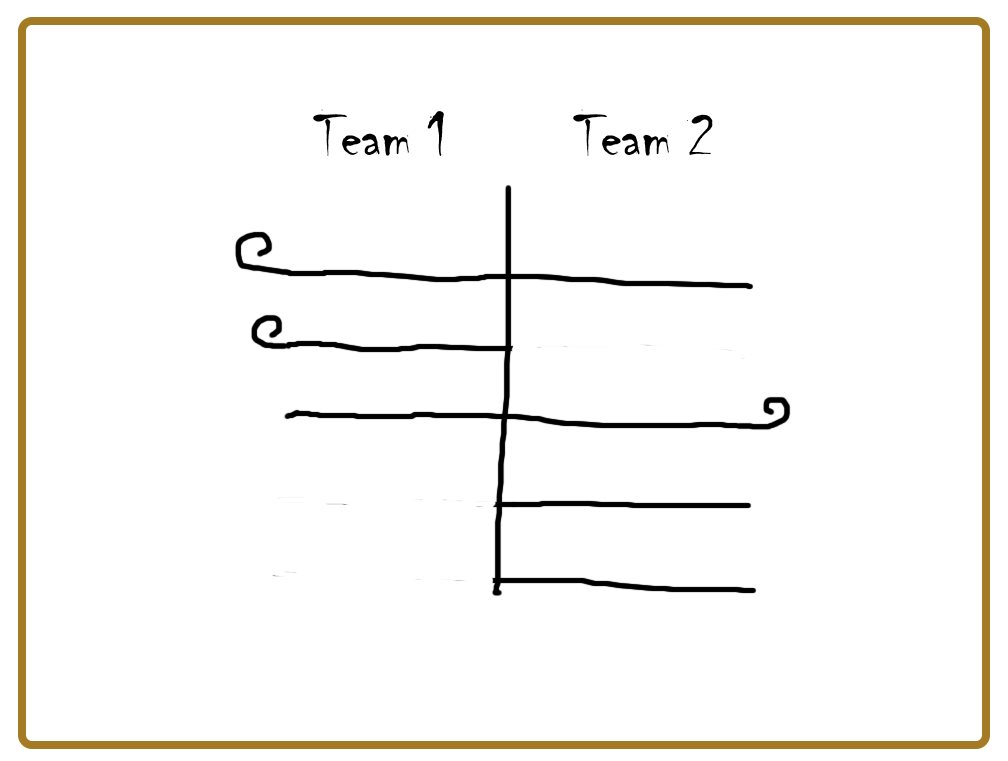
Whichever team has captured the most points during that hand wins the
hand. This team is entitled to erase one of the horizontal lines on that
partnerships side of the scoresheet. If a partnership who accepted trump on the
current hand loses the hand, they must draw a small loop at the end of one of the lines still remaining on their side of the scoresheet. This line is now a "Double" line. It requires two
wins to remove fully. One win will remove the small loop, and the next win will remove the full horizontal line. If both teams manage to capture the exact same score, neither partnership may remove a line on this round. However, after a tied hand, the next hand counts double (with the winners entitled to remove two lines from the scoresheet).
At any point in which a team manages to erase the last line on that partnership's side of the scoresheet, that partnership is declared the winner of the game.
Couillon Forcé: A popular variant of Couillon is Couillon
Forcé. This variant is played very identically to the standard version
as described above with the following differences:
- After the players received their original four cards, the player at the dealer's left may look at his cards. He then selects one card from his hand and lay it momentarily face-up on the table for all the players to see. The suit of this card will set the trump suit for the hand. After this, the dealer then deals one additional packet of two cards to each player.
- However, if this player prefers, he may defer selection of the trump suit, not showing a card. In this case, the dealer would simply deal the
additional two card packet to the player to his left, dealing one of these cards face-up. This face-up card is automatically set as the trump suit for the hand. After this player receives the
additional two card packet, the dealer deals the remaining three players an additional two cards as well, such that each player has 6 total cards.
- Each hand consists of six tricks played, with the player to the immediate left of the dealer leading to the first trick.
- If the partnership consisting of the player who set the trump scores fewer points than the opposing team, they must add one extra loop to their side of the scoresheet.
In all other aspects this variant is played identically to the standard version as described above.
Kwajongen: Kwajongen is a Flemish version of Couillon. This game is also played similarly to the base game as described above, with the following differences:
- The procedures of the actual deal are slightly different. In this version, the dealer first deals a two card packet to each other player and one face-up card to himself. He then deals another face-down two card packet to each other player and finally three face-down cards to himself. The card dealt face-up will designated the possible trump suit for the hand.
- Starting with the player to dealer's left, each player in turn may accept this trump suit (play) or decline this trump suit (pass). If all four players pass, the cards are gathered, shuffled and the deal rotates to the next player in turn.
- When playing to a trick led by another player a player must play a card of the same suit as that led to the trick. If they do not have a card of that suit, but they do have a card of the trump suit, they must play a card of the trump suit. If the player has neither a card of the suit led or the trump suit, they may play any other card from his hand.
- The scoresheet for Kwajongen is usually recorded using actual numbers rather than lines. Each team starts with 10 points. The team who captures more card points during the hand is entitled to subtract one point from it's score. If that team manages to win all four tricks, they are entitled to subtract two points from their current score. If the team who accepted the trump suit for the hand scores less than the opposing team, they must add one point to their current score.
- If both teams capture the same number of points, the team who accepted the trump suit for the hand must add one point to their current score.
- In the event that all players pass the deal is not played. On the next hand on which the captured points it not tied, the winning team scores one additional point for the hand.
- The first team to reduce it's score to 0 or less is the game winner.
In all other aspects Kwajongen is played identically to standard Couillon.
Troeven: This variant of Couillon is played extensively in the South of Holland, particularly in the Province of Limburg. This game is also very similar to Couillon with the following differences in play:
- Troeven uses the 32 card Euchre deck, which thusly constitutes of the normal deck used for Couillon with the addition of four sevens and four eights from a standard deck
(one of each denomination in each of the four suits). The ranking of the cards in this deck are as follows, from high to low; Ace, King, Queen, Jack, 10, 9, 8, 7.
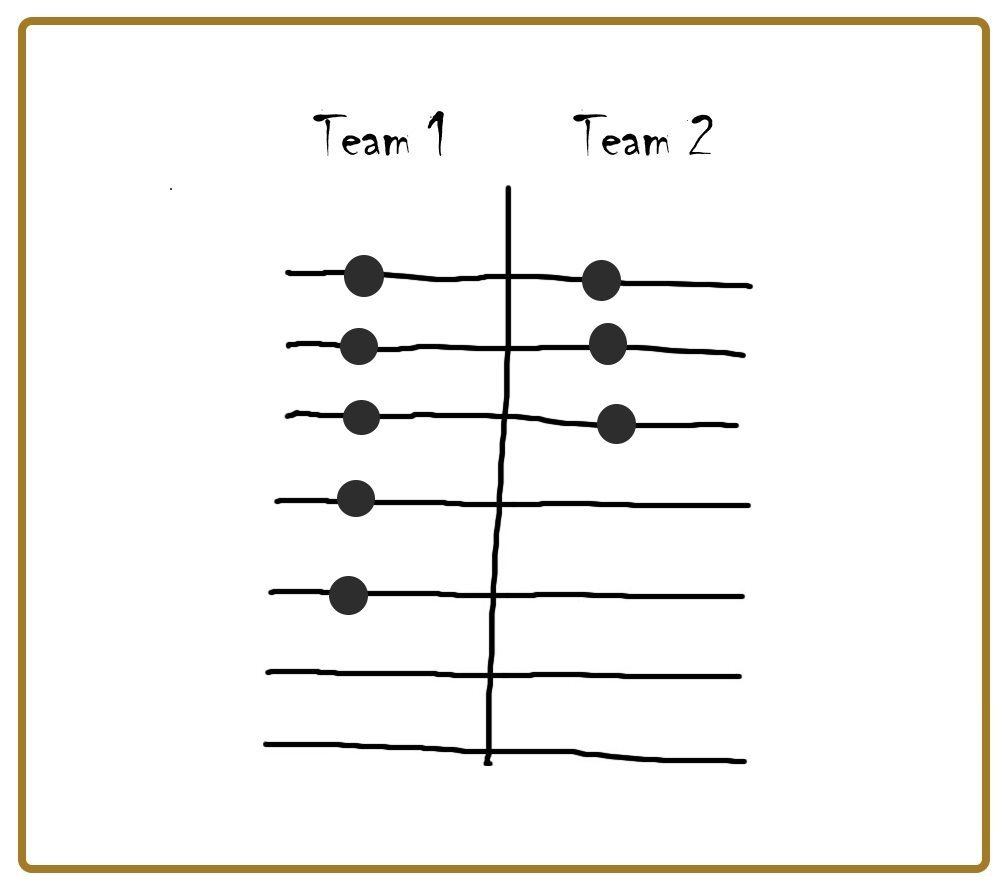
- To begin the deal, the dealer deals four cards to the player at his immediate left. This player then verbally announces his choice of a trump suit to be used for the hand. This suit does not necessarily need to be a suit of a card he currently has in hand. After this announcement, the dealer then deals the remaining three players a four card packet. He then deals a second four card packet to each player such that each player has an eight card hand.
- The player to the dealer's immediate left leads the first card to the first trick. If a player has a card of the suit led he must play it. If he does not have such a card he may play any card from his hand, including a card of the trump suit. The highest card of the trump suit played to the trick wins it. If no cards of the trump suit have been played to the trick, the highest card of the suit originally led to the trick wins it. The winner of each trick leads the first card to the next trick.
- A similar scoring diagram is used for this variant as in standard Couillon. However on a Troeven scoresheet, instead of erasing a horizontal line, a partnership would cancel this line out by adding a large dot or filled in circle on that line to indicate this. If the team who selects the trump suit for the hand does not earn more points than the opponent's team, they must add another horizontal line to their side of the scoresheet.
- If both teams tie for the number of card points captured during a hand, neither team scores for the current hand. However, the next team who manages to capture more points during a hand is entitled to erase two lines rather than just one on their side of the scoresheet.
- The scoresheet to be used for this game starts with seven horizontal lines which all must be canceled out by a team to win the game.
- The first team to erase all it's lines on the scoresheet is declared the winner of the game.
Kujong: Kujong is a German variant of Troeven that is played primarily in Luxembourg and other areas nearby. It is also played very similarly to the parent game Couillon, with the following differences:
- Kujong uses the same deck as used in standard Troeven and many of the variations.
- To begin the deal, the dealer deals three face-down cards only to the player at his immediate left. After looking at his cards, this player verbally selects a trump suit. After this occurs, the dealer deals a similar three card packet to the remaining players and then a final three card packet to each player. Each player would then have a total of six cards in hand.
- The Queen of Spades (called the Mit) is considered a special card in
this game, and the player holding that card may declare it on his turn, before he plays to the first trick. Doing this has two effects on gameplay. First, this card becomes the second highest card of the trump suit (regardless of the actual trump suit declared for the hand). This also allows this player's partnership, if they managed to capture the most card points in tricks, to cancel one additional line from the scoresheet.
- The score sheet for this game consists of nine short, vertical lines for each team. The team managing to capture more card points at the end of a hand is entitled to cancel one of these lines (usually by placing a slash or line through it).
- If the team that selected the trump suit for the hand captures fewer points than the opposing team, they must add one additional line on that teams side of the scoresheet.
- Winning all six tricks in a hand allows a team to cancel one additional line on the scoresheet.
- The first team to cancel out the last of their lines is considered to have won one game (also called a cow).
- The first team to win two cows is considered the session winner.
In all other aspects Kujong is played identically to Couillon as described above.
Copyright © 2015 CatsAtCards.com. All rights reserved.
 Couillon is designed to be played by four players playing in two
partnerships of two players each. It uses a special 24 card deck, which can
be created by removing all
cards lower than nine from a standard deck. The standard ranking of the cards used to play Couillon is as follows (from high to low); Ace, King, Queen, Jack, 10, 9. Since the scoring in this game is displayed by erasing from a scoresheet, scores should be recorded on something which can easily be erased from, such as a chalkboard or dry-erase board. To create the scoring indicator, a vertical line should be made down the middle of the board. The players consisting of one partnership are written on one side of this line and the names from the other on the other side. Five horizontal lines, equally spaced should then be drawn down the length of the original vertical line.
Couillon is designed to be played by four players playing in two
partnerships of two players each. It uses a special 24 card deck, which can
be created by removing all
cards lower than nine from a standard deck. The standard ranking of the cards used to play Couillon is as follows (from high to low); Ace, King, Queen, Jack, 10, 9. Since the scoring in this game is displayed by erasing from a scoresheet, scores should be recorded on something which can easily be erased from, such as a chalkboard or dry-erase board. To create the scoring indicator, a vertical line should be made down the middle of the board. The players consisting of one partnership are written on one side of this line and the names from the other on the other side. Five horizontal lines, equally spaced should then be drawn down the length of the original vertical line.
 Once the partnerships and first dealer have been determined, the dealer would then thoroughly shuffle the deck and offer it to the player at his immediate right to cut. After the cut, the dealer begins dealing, starting with the player to his left. He deals in face-down packets of two cards to each player in a clockwise direction around the table until each player has four total cards. He places the remaining 8 cards, also face-down, in a small stack in the center of the table. He then turns up the top card of this stack and places it face-up beside the stack.
Once the partnerships and first dealer have been determined, the dealer would then thoroughly shuffle the deck and offer it to the player at his immediate right to cut. After the cut, the dealer begins dealing, starting with the player to his left. He deals in face-down packets of two cards to each player in a clockwise direction around the table until each player has four total cards. He places the remaining 8 cards, also face-down, in a small stack in the center of the table. He then turns up the top card of this stack and places it face-up beside the stack.

 Whichever team has captured the most points during that hand wins the
hand. This team is entitled to erase one of the horizontal lines on that
partnerships side of the scoresheet. If a partnership who accepted trump on the
current hand loses the hand, they must draw a small loop at the end of one of the lines still remaining on their side of the scoresheet. This line is now a "Double" line. It requires two
wins to remove fully. One win will remove the small loop, and the next win will remove the full horizontal line. If both teams manage to capture the exact same score, neither partnership may remove a line on this round. However, after a tied hand, the next hand counts double (with the winners entitled to remove two lines from the scoresheet).
Whichever team has captured the most points during that hand wins the
hand. This team is entitled to erase one of the horizontal lines on that
partnerships side of the scoresheet. If a partnership who accepted trump on the
current hand loses the hand, they must draw a small loop at the end of one of the lines still remaining on their side of the scoresheet. This line is now a "Double" line. It requires two
wins to remove fully. One win will remove the small loop, and the next win will remove the full horizontal line. If both teams manage to capture the exact same score, neither partnership may remove a line on this round. However, after a tied hand, the next hand counts double (with the winners entitled to remove two lines from the scoresheet).
